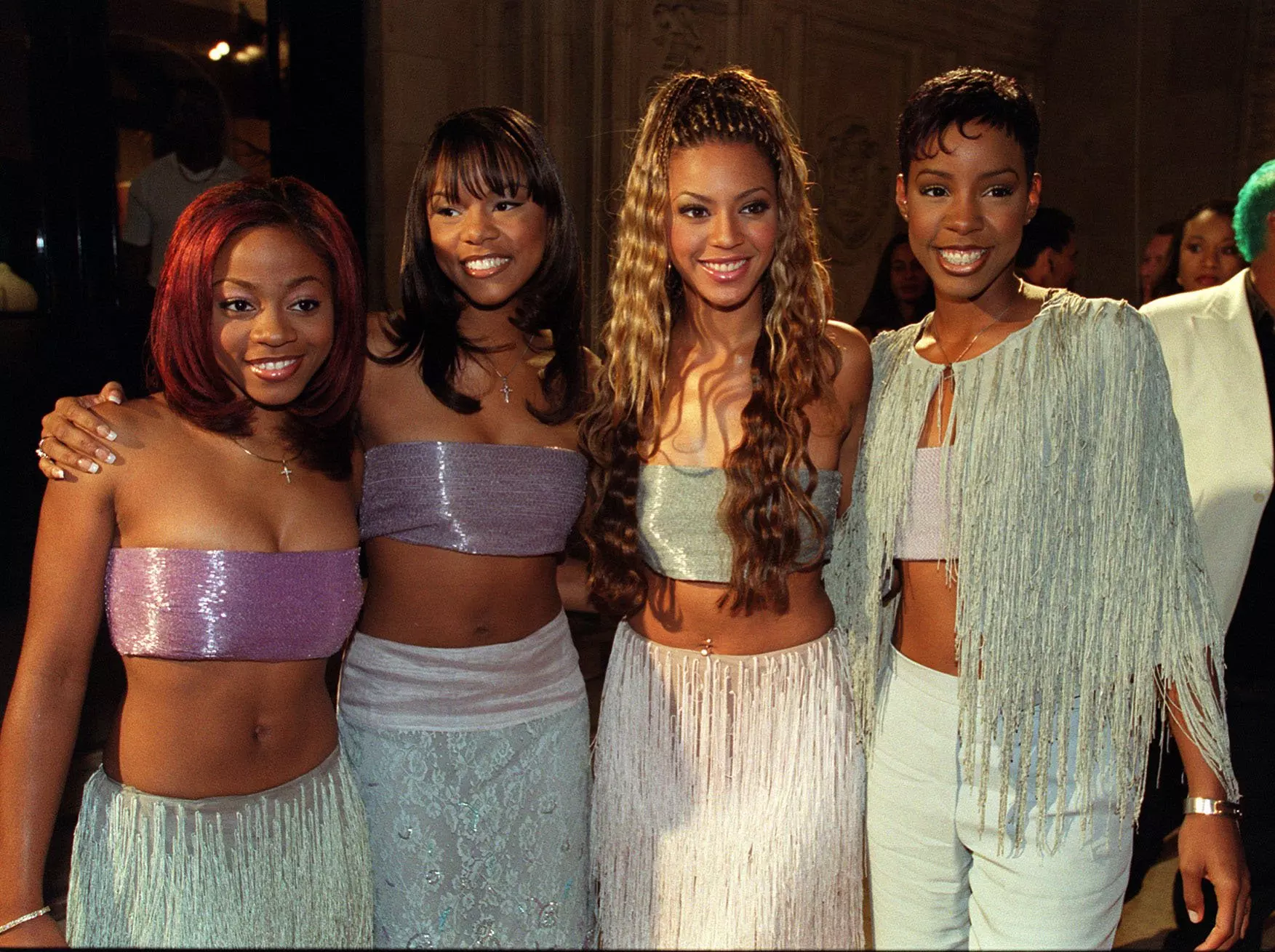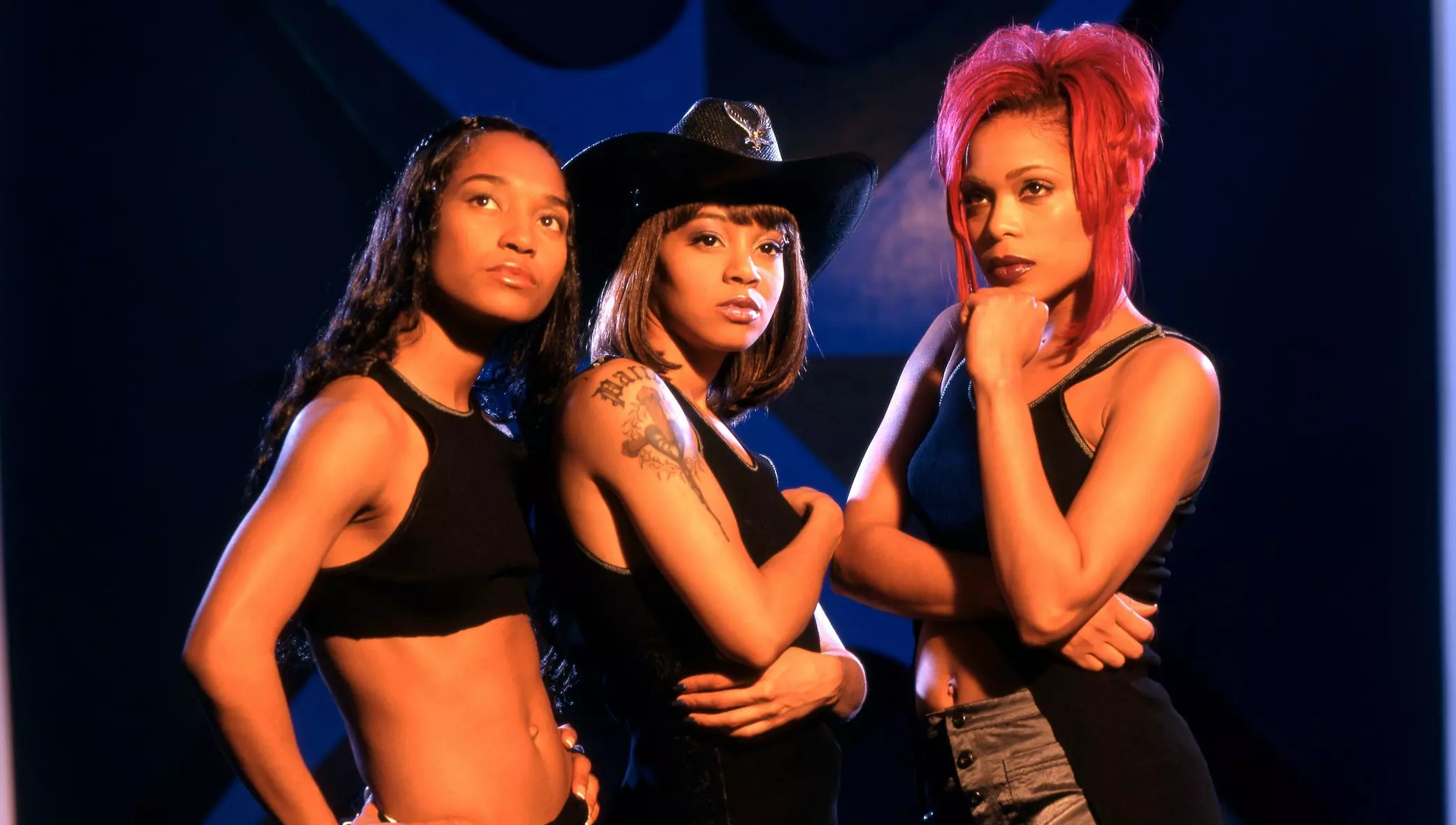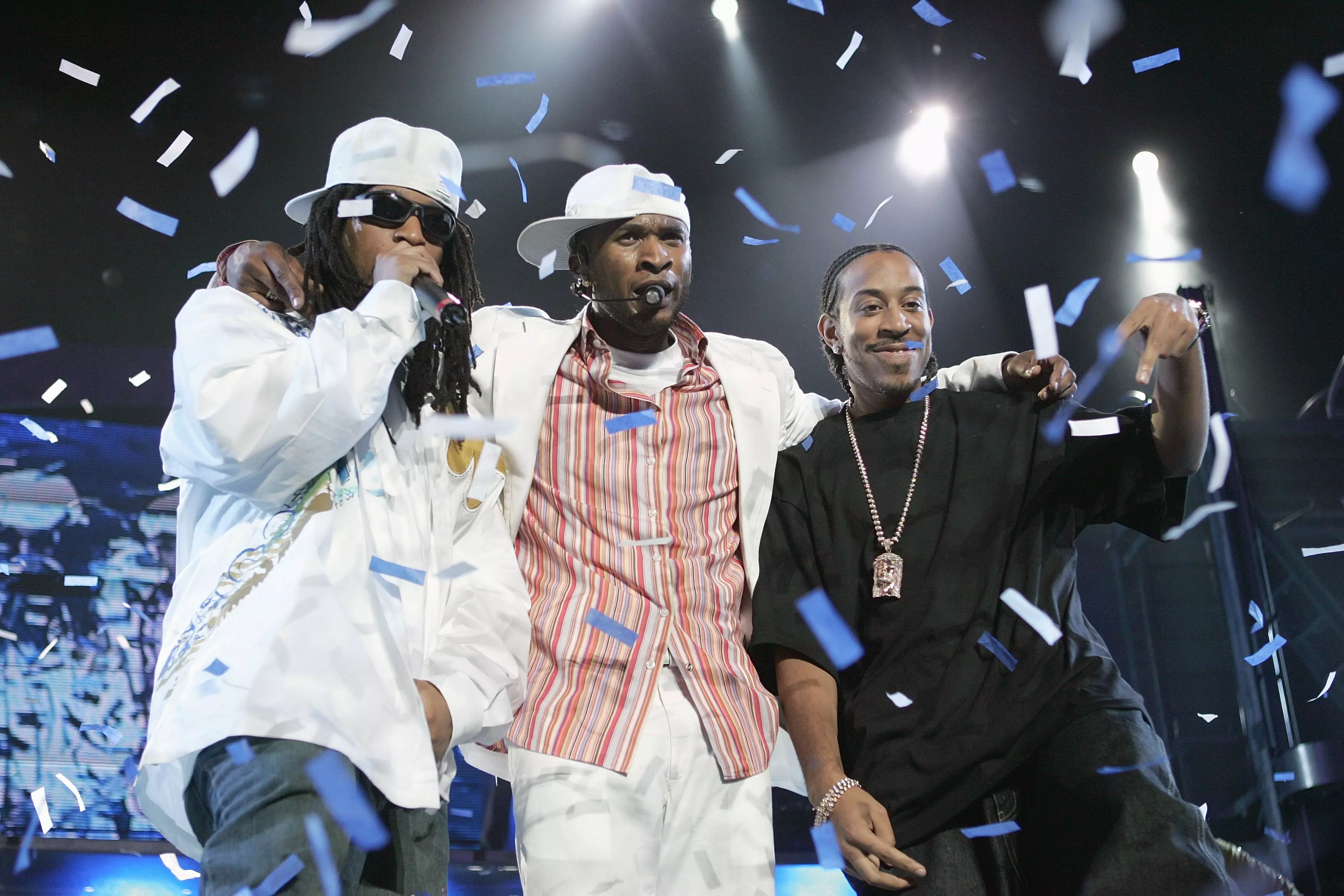Photo: Andy Lyons/Getty Images
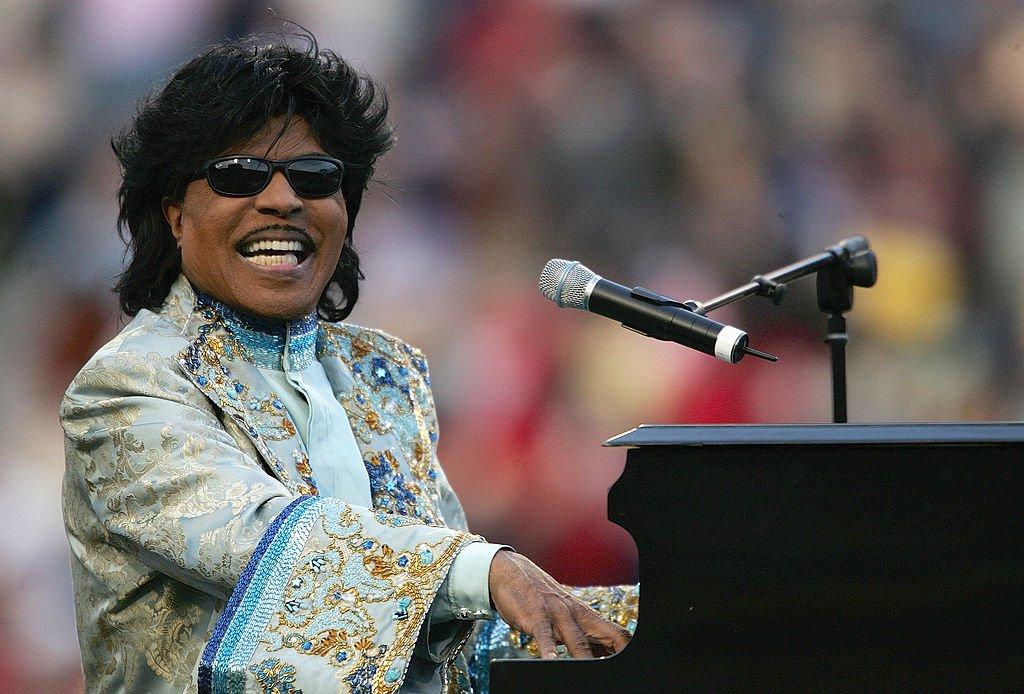
Little Richard performs in 2004
news
Remembering The Life, Legacy And Music Of Little Richard: Rock Pioneer And GRAMMY Lifetime Achievement Award Recipient
Known as the "Architect Of Rock And Roll," Little Richard shaped the sound and established the foundation of the rock genre via his eternal hits like "Tutti Frutti" "Long Tall Sally" and "Lucille"
Musical icon Little Richard, an architect and pioneer of rock 'n' roll, a GRAMMY Lifetime Achievement Award Recipient and a GRAMMY Hall Of Fame inductee, died Saturday (May 9). He was 87.
His son, Danny Jones Penniman, confirmed the news of Little Richard's death to Rolling Stone, with the artist's lawyer, Bill Sobel, citing bone cancer as the cause of death.
<style>.embed-container { position: relative; padding-bottom: 56.25%; height: 0; overflow: hidden; max-width: 100%; } .embed-container iframe, .embed-container object, .embed-container embed { position: absolute; top: 0; left: 0; width: 100%; height: 100%; }</style><div class='embed-container'><iframe src='https://www.youtube.com/embed/ivhauEr3KxU' frameborder='0' allowfullscreen></iframe></div>
Harvey Mason jr., Chair and Interim President/CEO of the Recording Academy, shared a touching message about Little Richard's passing on behalf of the organization.
"As one of the founding fathers of rock and roll, Little Richard's music and persona is one of the most recognized and celebrated voices of American music, influencing artists across all genres today," Mason jr. said. "Little Richard's legacy will be remembered by music fans for generations to come."
With a career spanning over six decades, Little Richard played an integral role in shaping the sound and establishing the foundation of the then-burgeoning rock 'n' roll genre. His high-energy music, flamboyant performance style, impassioned sing-shout vocals, outrageous costumes and androgynous onstage persona comprised the singer's signature look and sound on an individual level, while also personifying and defining some of the key sonic and visual elements that would inform the rock genre. While his music ranged in the rock and R&B umbrella genres, the singer impacted artists from a wide array of backgrounds, from rock to hip-hop, with several of his contemporaries recording covers of his originals, including The Beatles, Elvis Presley, Buddy Holly and Jerry Lee Lewis, among many others. As well, his music also helped shape whole genres, including funk and soul. Little Richard ultimately earned the nickname the "Architect Of Rock And Roll."
Born Richard Wayne Penniman in Macon, Ga., in 1932, he first broke out as Little Richard in the mid-'50s on the strength of a string of hit singles, including "Tutti Frutti," "Long Tall Sally" and "Rip It Up," all in 1956, followed by "Lucille" in 1957 and "Good Golly Miss Molly" in 1958, all of which became his staple songs and "part of the rock & roll canon," Rolling Stone notes.
Read: Little Richard Was The Lightning Storm That Awakened Rock
Born into a large religious family—he was one of 12 children—Penniman began his musical career signing in a local church at a young age before leaving his home at 13 after his father accused him of being gay.
Sister Rosetta Tharpe, a rock 'n' roll pioneer herself and a major influence on Little Richard, gave Penniman his first paid live music gig, opening her show at Macon City Auditorium, in 1947 when he was 14. The event would convince Penniman to pursue music as a full-time career. On a professional level, Penniman landed his first record deal in 1951, signing with RCA. However, his stint with the label failed to produce national success.
Penniman would finally gain national chart success with "Tutti Frutti." Released on Chicago imprint Specialty Records in 1955, the song became Little Richard's breakout single and his first major hit, reaching No. 17 on the pop charts. The iconic song, which contained Little Richard's eternal balderdash lyrics, "A-wop-bom-a-loo-mop-a-lomp-bom-bom," has been covered by Pat Boone, Elvis Presley and The Beatles.
<style>.embed-container { position: relative; padding-bottom: 56.25%; height: 0; overflow: hidden; max-width: 100%; } .embed-container iframe, .embed-container object, .embed-container embed { position: absolute; top: 0; left: 0; width: 100%; height: 100%; }</style><div class='embed-container'><iframe src='https://www.youtube.com/embed//hCPTLd3ZPX8' frameborder='0' allowfullscreen></iframe></div>
Little Richard released his debut album, Here's Little Richard, in 1957; the LP reached No. 13 on what was then known as the Best Selling Pop Albums chart, according to Billboard. Later that year, the singer announced he was quitting music professionally and turning to religion, becoming an ordained minister. He released a gospel set, God Is Real, in 1959, according to Rolling Stone.
After his gospel career failed to take off, Little Richard returned to secular music in the early '60s, though his music would never reach the success he achieved during his breakout run in the '50s, outside of occasional charting songs.
Following an addiction to cocaine, Little Richard again quit music for religion in the mid-'70s; he released another gospel album, God's Beautiful City, in 1979. He stopped making albums altogether in 1992, Billboard notes. He continued to tour and perform extensively into his later years. However, after a hip replacement surgery in 2009, he announced his retirement from performing in 2013.
<style>.embed-container { position: relative; padding-bottom: 56.25%; height: 0; overflow: hidden; max-width: 100%; } .embed-container iframe, .embed-container object, .embed-container embed { position: absolute; top: 0; left: 0; width: 100%; height: 100%; }</style><div class='embed-container'><iframe src='https://www.youtube.com/embed/fzDJOyZjTVg' frameborder='0' allowfullscreen></iframe></div>
Outside of music, Little Richard also dabbled in acting. He had roles and cameos on films like Down And Out In Beverly Hills and The Naked Truth as well as TV shows like "Full House," "Baywatch" and "The Simpsons" between the '80s and 2000s. The 2000 eponymous biopic, Little Richard, starring actor/singer Leon in the lead role, chronicled the singer's early years and rise in music through the '50s and '60s.
Recognized as one of the first black crossover artists, Little Richard's music and legacy also challenged, and often broke, many cultural and societal barriers. In a 1984 interview on "Today," he told Bryant Gumbel his "joyful music" "brought the races together."
"White people were sitting upstairs, black people downstairs. And the white people, when I started singing, they would jump over the balcony and come down there with us, so it brought them together," Little Richard said in the interview, speaking of his early music days in the American South when concerts were still largely segregated.
Little Richard also noted the importance of his 1956 hit song, "Tutti Frutti," in breaking color barriers. "'Tutti Frutti' really started the races being together … From the git-go, my music was accepted by whites," he told Rolling Stone in 1990.
He also shattered sexual stereotypes in rock and pop culture through his androgynous image and stage persona. He performed in drag in his early years, and his flamboyant, effeminate performance style and personality would "set the standard for rock & roll showmanship," Rolling Stone writes. His influence in this space would later be seen in fellow gender-bending rock stars like David Bowie, Freddie Mercury and Prince.
In addition to being inducted into the Rock & Roll Hall Of Fame as part of the institution's inaugural class in 1986, Little Richard is also an inductee of the Songwriters Hall Of Fame. He received the Recording Academy's Lifetime Achievement Award in 1993. Four of his recordings were inducted into the GRAMMY Hall Of Fame: his 1957 debut album, Here's Little Richard, in 2013, as well as his classic songs "Tutti Frutti" in 1998, "Long Tall Sally" in 1999 and "Lucille" in 2002.
Little Richard is survived by his son, Danny Jones Penniman; a complete list of surviving family members is not yet available, The New York Times reports.
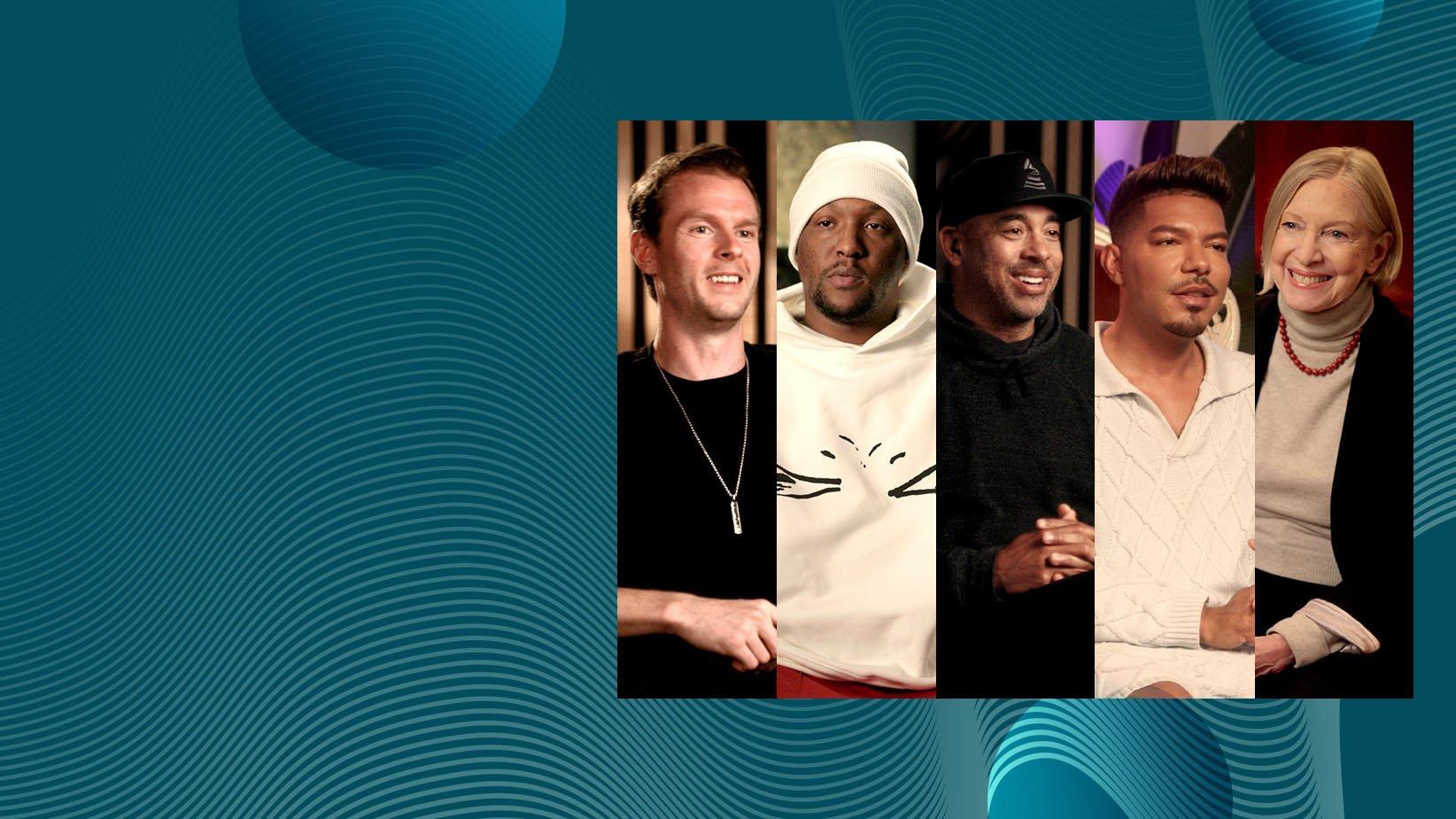
Photos Courtesy of the Recording Academy
news
The New GRAMMY GO Music Production Course Is Now Open: Featuring GRAMMY Winners Hit-Boy, CIRKUT, Judith Sherman & More
Enrollment is now open for GRAMMY GO's new specialization, "Music Production: Crafting Award-Worthy Songs," featuring appearances by GRAMMY winners and nominees. Learn music production and creative strategies from today's industry leaders.
Editor’s Note: Updated to add the Instagram Live video featuring Harvey Mason jr. and Stevie Mackey.
The Recording Academy continues its mission to empower music's next generation with the launch of its second specialization in the GRAMMY GO platform: "Music Production: Crafting Award-Worthy Songs."
This new course, a partnership between the Recording Academy and leading online learning platform Coursera, aims to bolster the technological and audio skills of music producers of all levels. The course, taught by Howard University professor and GRAMMY nominee Carolyn Malachi, features appearances by three-time GRAMMY winner and rap icon Hit-Boy, chart-topping and GRAMMY-winning producer/songwriter CIRKUT, artist and celebrity vocal coach Stevie Mackey, five-time GRAMMY nominee and Recording Academy CEO Harvey Mason jr., and 15-time GRAMMY winner Judith Sherman.
Enrollment for "Music Production: Crafting Award-Worthy Songs" is open now.
Mixing a unique blend of theory and practice, the course teaches music creators of all levels the advanced skills and tools to develop the mindset and confidence of an experienced producer and produce songs of the highest industry standards across all genres. Explore the wide-ranging roles of a music producer, develop critical listening and analysis skills, and master the technical aspects to create music and compositions that cut through the noise. The course's applied learning approach allows learners to sharpen their pre-production skills, utilize Digital Audio Workstations (DAWs) effectively, and produce vocals, instrumentals and samples collaboratively. Through critical listening exercises and discussions, learners will refine their abilities to deliver professional-quality demos.
To celebrate the launch, the Recording Academy hosted an Instagram Live session on Tuesday in which guests Harvey Mason jr. and Stevie Mackey discussed the evolving role of music producers, strategies for working with artists, key elements of top-notch productions, common mixing mistakes, tips for keeping the creative process fresh, and enrollment details for the course.
Building on the success of its first specialization, "Building Your Audience for Music Professionals," GRAMMY GO continues to offer industry-focused education tailored for emerging and established music creators and professionals alike. The innovative platform provides learners with real-time insights from leading music industry figures, ensuring the content remains practical and up to date. GRAMMY GO will also serve as an essential tool in the Recording Academy's global expansion into Africa and the Middle East, empowering music creators through enhanced training, bridging knowledge gaps, and fostering connections within the global music community.
Launched in April in partnership with Coursera, GRAMMY GO is the Recording Academy's first creator-to-creator platform, offering innovative courses tailored for both emerging and established music professionals. The initiative accelerates the Academy's global mission and reinforces its commitment to music education, providing a seamless bridge between all Academy initiatives.
Learn more about GRAMMY GO and the "Music Production: Crafting Award-Worthy Songs" and "Building Your Audience for Music Professionals" specializations.
Watch the Instagram Live session with Harvey Mason jr. and Stevie Mackey in full below:
More Music Education News & Initiatives
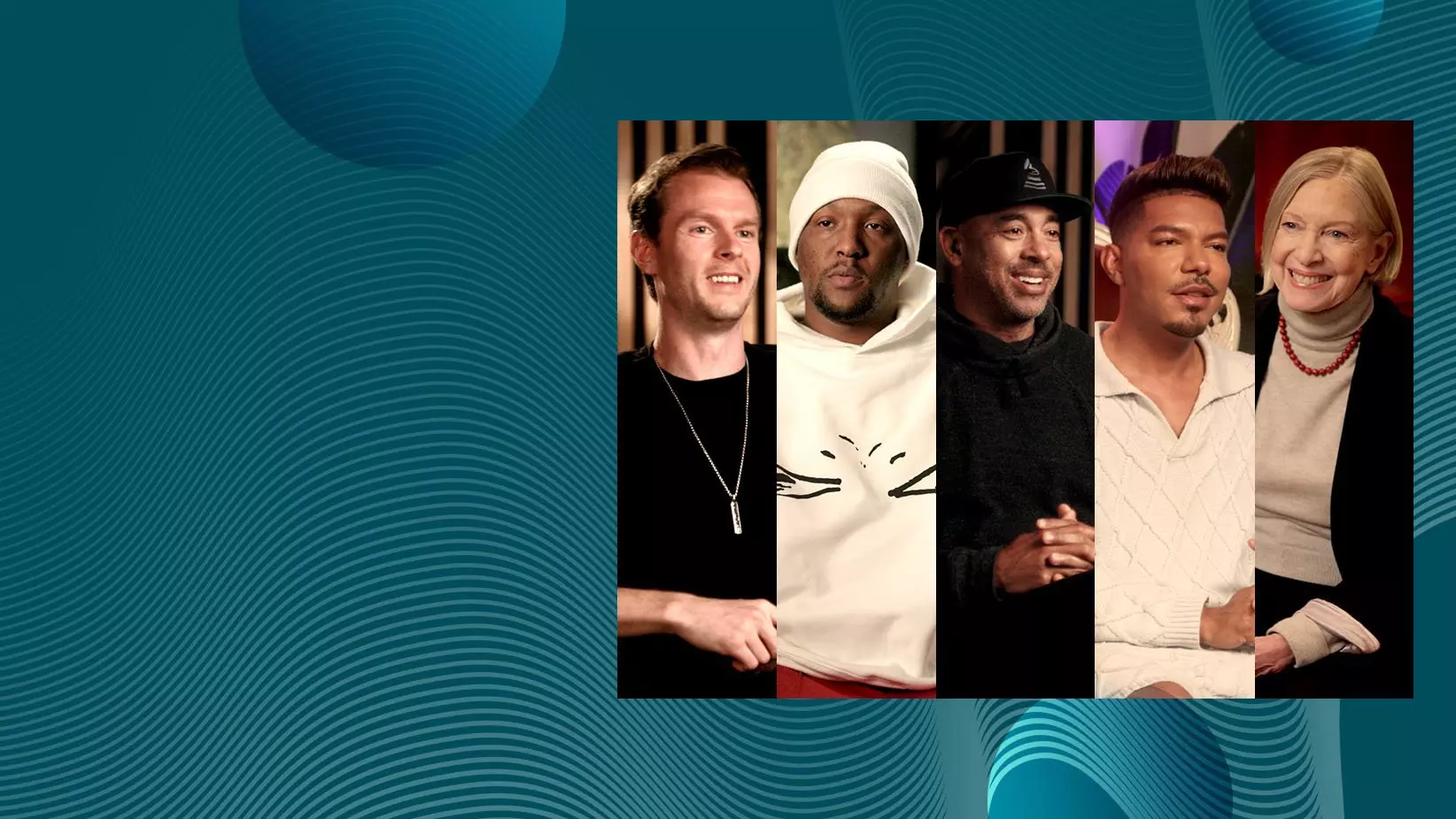
The New GRAMMY GO Music Production Course Is Now Open: Featuring GRAMMY Winners Hit-Boy, CIRKUT, Judith Sherman & More
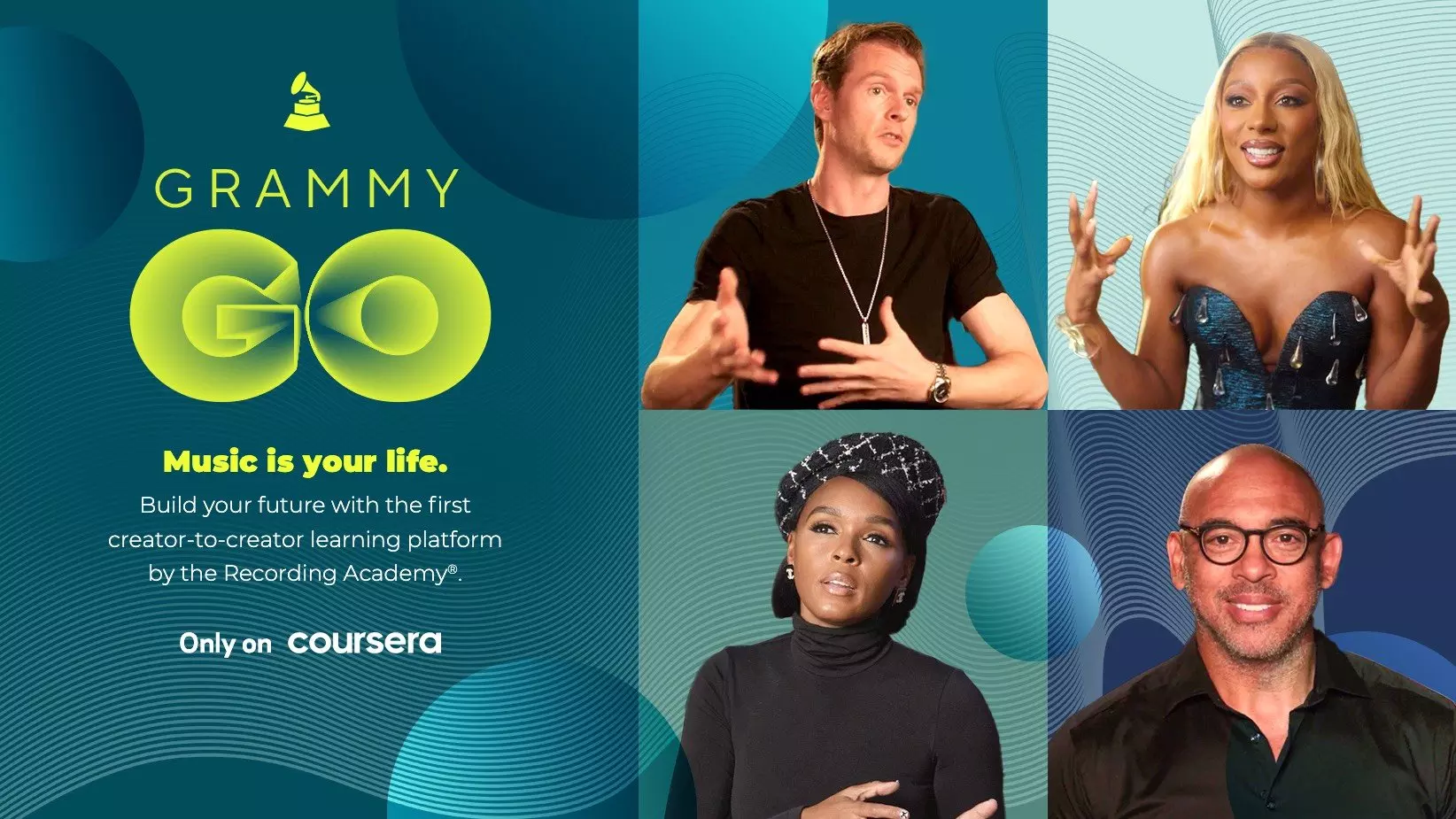
Recording Academy & Coursera Partner To Launch GRAMMY GO Online Learning Initiative

25 Semifinalists Announced For The 2024 Music Educator Award

5 Music Teachers Share The Transformative Power Of Music Education

Meet Mother Nature, The Chicago Rap Duo That Teach & Live Self-Expression Through Their Miseducation Of HipHop Youth Workshops

Photo: Paul Natkin/Getty Images
list
8 Ways Sade's 'Diamond Life' Album Redefined '80s Music & Influenced Culture
As Sade's masterpiece 'Diamond Life' turns 40, see how the group's debut pushed R&B forward and introduced them as beloved elusive stars.
"I only make records when I feel I have something to say," Sade Adu asserted in 2010 upon the highly anticipated release of Sade's GRAMMY-winning Soldier of Love album, which arrived after a 10-year hiatus. "I'm not interested in releasing music just for the sake of selling something. Sade is not a brand."
This lifetime of dedication toward achieving musical excellence helped Sade — vocalist Adu, bassist Paul S. Denman, keyboardist Andrew Hale, and guitarist/saxophonist Stuart Matthewman — gain prominence in the mid-80s, also garnering enormous respect from fans, critics, and peers alike. Formed in 1982, the English band is one of the few acts that can still be met with a hungry audience after disappearing from the spotlight for multiple years.
In an industry where churning out a new body of work is expected every couple of years, the four meticulous members of Sade move on their own time, putting out a mere six studio albums since 1984. Every project becomes more exquisite than the last, but it all began 40 years ago with Sade's illustrious debut album, Diamond Life. Ubiquitous hits like "Smooth Operator" and "Your Love Is King" appealed to listeners young and old — offering a unique blend of R&B, jazz, soul, funk, and pop that birthed a new sound and forced the industry to take notes from the jump.
As Sade's Diamond Life celebrates a milestone anniversary, here's a look at how the album helped push R&B forward, and why it's just as relevant today.
It Helped Set Off The "Quiet Storm" Craze
By mid-1984, Michael Jackson, was riding high off of winning the most GRAMMYs in a single night (including Album Of The Year) for his blockbuster album Thriller, Madonna celebrated her first top 10 hit with "Borderline," and Prince's Purple Rain was just days away from its theatrical release. Duran Duran, Culture Club, Billy Idol, and the Police were mainstays, while "blue-eyed soul" in particular had also hit an all-time high thanks to Hall and Oates, Wham, Simply Red, and others. What's more, many Black artists like Lionel Richie and Whitney Houston opted for more of a pop sound to appeal to broader audiences during MTV's golden era.
Diamond Life was refreshing at the time, as it fully embraced soul and R&B. The album offered a chic sophistication amid the synth-heavy pop and rock music that ruled the charts.
Singles like "Your Love Is King" and "Smooth Operator" introduced jazz elements into mainstream radio. In turn, Sade helped usher in the "quiet storm" genre — R&B music at its core, with strong undertones of jazz for an ultra-smooth sound. Sade and Diamond Life also laid some of the groundwork for neo-soul, which saw a surge in the '90s à la Lauryn Hill, Maxwell, and Erykah Badu.
It Made GRAMMY History
In the 65-year history of the GRAMMYs, a small number of Nigerian artists, including Burna Boy and Tems, have won a golden gramophone. In 1986, a then 27-year-old Sade Adu made history as the first-ever Nigerian-born artist to win a GRAMMY when she and her band was crowned Best New Artist at the 29th GRAMMYs. Still, Billy Crystal and Whoopi Goldberg had to accept the award on Sade's behalf — signaling Adu's elusive nature as she rarely attends industry events or grants interviews.
Since then, Sade has gone on to earn three more GRAMMYs, including Best Pop Vocal Album in 2001 for their fifth studio album, Lovers Rock. The win signified their staying power in the new millennium.
It Birthed The Band's Signature Song…
While Diamond Life spawned timeless hits like "Your Love Is King" and "Hang On to Your Love," "Smooth Operator" became the album's highest-charting single — and remains the most iconic song in their catalog. The seductive track about a cunning two-timer propelled the band into international stardom: "Smooth Operator" skyrocketed to No. 5 on the Billboard Hot 100 and hit No. 1 on the Adult Contemporary chart.
Even non-Sade fans can identify "Smooth Operator" in an instant, from Adu's unmistakable vocals to that now-iconic instrumental saxophone solo. As of press time, it boasts over 400 million Spotify streams alone, and has remained a set list staple across every one of Sade's tours.
…And It Houses Underrated Gems
"Smooth Operator" may be Sade's commercial classic, but deep cuts like "Frankie's First Affair," "Cherry Pie," and "I Will Be Your Friend" are fan favorites that embody the band's heart and soul.
"Frankie's First Affair" offers a surprisingly enchanting take on infidelity: "Frankie, didn't I tell you, you've got the world in the palm of your hand/ Frankie, didn't I tell you they're running at your command." And, it's impossible to resist the funky groove that carries standout track "Cherry Pie," which served as a catalyst for some of Sade's later, more dance-oriented hits, including "Never As Good As the First Time" and "Paradise." Some of Sade's most poignant statements about lost love, including "Somebody Already Broke My Heart" from 2000's Lovers Rock, can be traced back to "Cherry Pie."
Diamond Life's penultimate song, "I Will Be Your Friend," offers both solace and companionship — another recurring theme throughout Sade's music, from 1988's "Keep Looking" to 2010's "In Another Time."
It Was The Best-Selling Debut Album By A British Female Singer For More Than Two Decades
Sade has sold tens of millions of albums worldwide, but Diamond Life remains the band's most commercially successful LP with over 7 million copies sold. Most of Sade's other platinum-selling LPs, including Diamond Life's follow-up, 1985's Promise, boast sales between four and six million copies.
The 7 million feat helped Sade set the record for best-selling debut album by a British female singer. She held the title for nearly 25 years until Leona Lewis' 2008 album Spirit, which has sold over 8 million copies globally.
It Introduced Sade Adu As A Style Icon
When we first met Adu, her signature aesthetic consisted of a long, slicked-back ponytail, red lip, and gold hoops. Sade's impeccable style is front and center in early videos like "When Am I Going to Make a Living," in which she sports an all-white ensemble paired with a pale gray, ankle-length trench coat and loafers.
Adu rocked the model off-duty style long before it became a trend. Her oversized blazers, classic trousers, and head-to-toe denim looks were as effortless as they were chic and runway-ready — proving that less was more amid the decade of excess.
"It's now so acceptable to be wacky and have hair that goes in 101 directions and has several colours, and trendy, wacky clothes have become so acceptable that they're… conventional," Adu, who briefly worked as a fashion designer and model before pursuing music, told Rolling Stone in 1985. "I don't like looking outrageous. I don't want to look like everybody else."
It Shined A Light On Larger Societal Issues
While most of Diamond Life leans into love's ebbs and flows, a handful of tunes deal with financial strife coupled with a dose of optimism, as evidenced by "When Am I Going to Make a Living" and "Sally." The latter song characterizes the Salvation Army as a young charitable woman: "So put your hands together for Sally/ She's the one who cared for him/ Put your hands together for Sally/ She was there when his luck was running thin."
Meanwhile, Adu, a then-starving artist, scribbled down portions of "When Am I Going to Make a Living" on the back of her cleaning ticket. The soul-stirring "We are hungry, but we won't give in" refrain emerges as a powerful mantra in the face of adversity and still holds relevance in 2024. Similar themes appear throughout Sade's later work, including unemployment ("Feel No Pain"), unwanted pregnancy ("Tar Baby"), survival ("Jezebel"), prejudice ("Immigrant"), and injustice ("Slave Song").
Diamond Life closer "Why Can't We Live Together" is a well-done cover of Timmy Thomas' 1972 hit about the staggering Vietnam War deaths. The band wisely doesn't veer too far from the original recording, but Adu's distinctive contralto voice brings a haunting quality that's reminiscent of Billie Holiday.
It Ignited The Public's Ongoing Fascination With Sade Adu
Since 1984, Sade has only released six studio albums, and a remarkable 14 years have passed since the group's last offering, 2010's Soldier of Love. Ironically, that scarcity — both in terms of music and access to the artist — has actually added to Adu's appeal. Case in point: Sade's sold-out Soldier of Love Tour grossed over $50 million in 2011, and the band still brings in close to 14 million monthly listeners on Spotify.
Adu's striking beauty, mysterious persona, and knack for letting her music do all the talking has earned the admiration of her peers across genres and generations. Everyone from Beyoncé to Kanye West to Snoop Dogg have sung her praises. Drake even has two portrait-style tattoos of the singer on his torso. Prince reportedly described 1988's "Love Is Stronger Than Pride" as "one of the most beautiful songs ever." Metalheads Chino Moreno of the Deftones and Greg Puciato of the Dillinger Escape Plan have also cited Adu as inspiration — showing that her influence runs far and wide.
In 2022, reports circulated that Sade was recording new music at Miraval Studios in France. But upon Diamond Life's 40th anniversary, "Flower of the Universe" and "The Big Unknown" from the respective soundtracks to 2018 films A Wrinkle in Time and Widows stand as Sade's latest releases.
Whether fans get new music anytime soon remains to be seen, but the impressive repertoire of Adu, Denman, Hale, and Matthewman is one that aims to be truth-seeking and inspiring while exploring life's peaks and valleys. Diamond Life in particular holds up as one of the purest representations of the group's creative legacy, both commercially and musically.
From quadruple platinum status to resonating with several generations, Diamond Life will forever stand as a remarkable debut — one that continues to influence music in a multitude of ways.
Latest News & Exclusive Videos

2024 Paris Olympics Opening Ceremony: Watch Celine Dion, Lady Gaga, Gojira & More Perform

Ice Spice Is The Drill Queen On 'Y2K!': 5 Takeaways From Her Debut Album

New Music Friday: Listen To New Songs From Halsey, MGK And Jelly Roll, XG & More

Watch Young MC Win Best Rap Performance In 1990

The Red Clay Strays Offer A New Kind Of Religion With 'Made By These Moments'
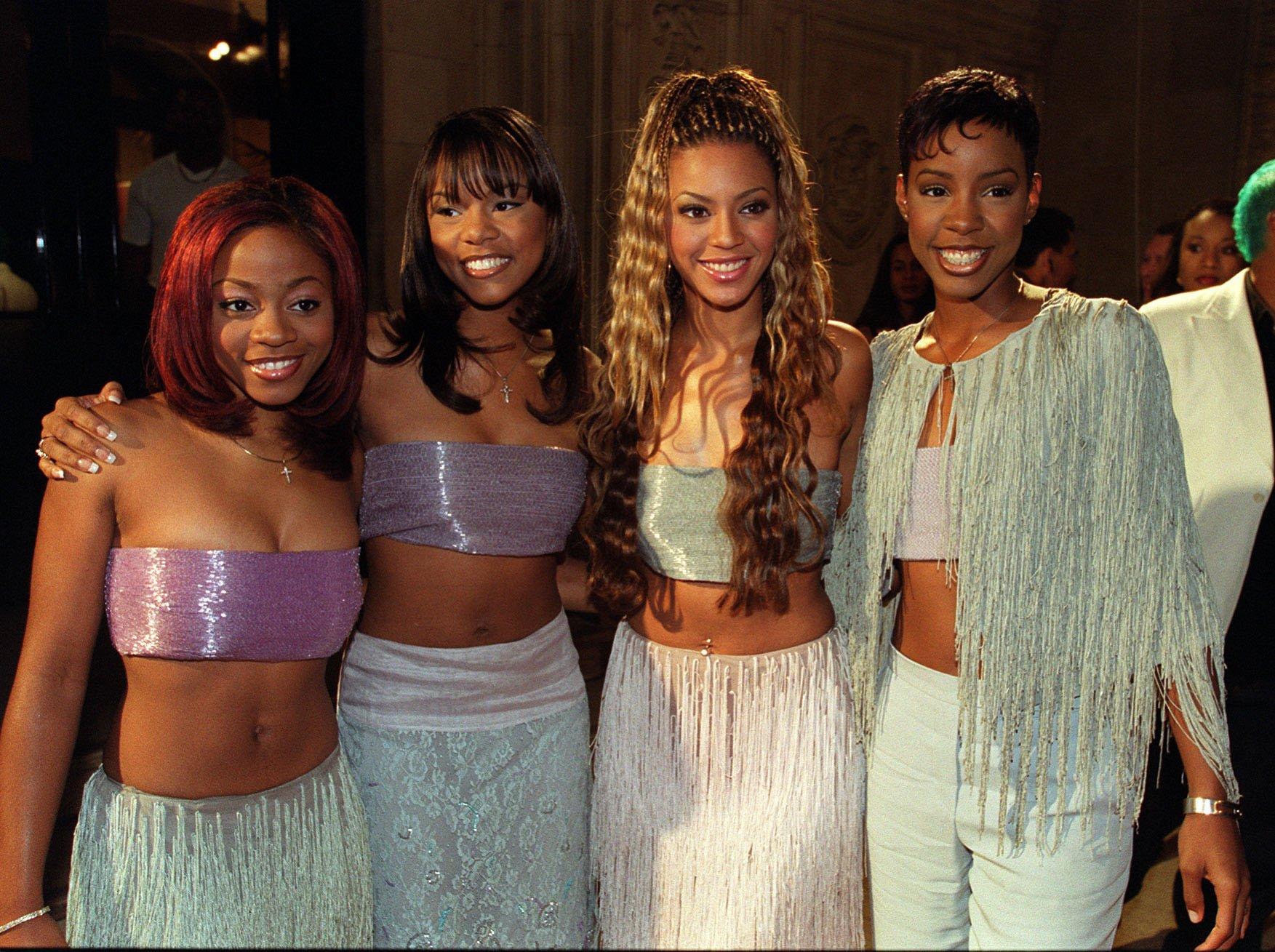
Photo: Michael Crabtree - PA Images/PA Images via Getty Images
list
5 Reasons Why 'The Writing's On The Wall' Is Destiny's Child's Defining Album
From its embrace of experimental R&B production and memorable music videos, to its GRAMMY-winning empowering songs, 'The Writing’s On the Wall' remains a touchstone for fans of Destiny's Child.
In 1997, all-female R&B groups were thriving: TLC already had seven Top 10 hits on the Billboard Hot 100, En Vogue had numerous platinum singles, and Xscape reached No. 1 more than once. Soon, a quartet of teenagers would burst upon the scene and leave an indelible impact.
While Destiny’s Child are now canonical in the world of '90s and early aughts R&B, the group initially experienced spotty success. Their 1997 debut single, "No, No, No (Part 2)" peaked at No. 3 on Billboard’s Hot 100 and was certified platinum. Yet their eponymous album, released in February 1998, only hit No. 67. Their follow up single, "With Me," also failed to set the charts ablaze.
Destiny’s Child's underwhelming chart performances could’ve easily derailed the budding group. Fortunately, the four ambitious girls from Texas had other plans.
Beyoncé Knowles, Kelly Rowland, LaTavia Roberson, and Le Toya Luckett were determined not to become one hit wonders, and quickly went back into the studio to record their sophomore album. Released on July 14, 1999, The Writing’s On the Wall became Destiny’s Child’s highest selling album and spawned some of their most iconic songs — one of which led to the group's first GRAMMY win. Not only did the album establish Destiny's Child as a household name, but it fine tuned the R&B girl group concept to perfection.
"We had no idea that The Writing's on the Wall would be as big a record as it was. Especially worldwide," Beyoncé said in a 2006 Guardian interview.
In celebration of the iconic album's 25th anniversary, read on for five reasons why The Writing’s On the Wall is the defining album of Destiny’s Child’s career.
Its Members Took Creative Control
On their debut album, Destiny’s Child tapped into the neo soul trend popularized by the likes of D’Angelo, Erykah Badu, and Maxwell — artists in their early-to-mid twenties with a maturity the teen quartet didn’t yet have. The references and creative direction clashed with the reality of the group members being so young.
"It was a neo-soul record and we were 15 years old. It was way too mature for us," Beyoncé tol the Guardian.
Heading back into the studio, the girls made sure to eradicate any misalignments and put more of themselves into their sophomore album. In an interview with MTV, the members said The Writing’s On the Wall had a fresher, more youthful vibe because "it comes from us." The quartet's fingerprints are all over the 16 track album: Each member co-wrote at least 50 percent of the album.
"Even at the time, Beyoncé would produce a lot of their background vocals, and she was a leader even at a young age," Xscape's Kandi Burruss said in a Vice interview, reflecting on her work as a songwriter and producer on The Writing's On the Wall. This heightened presence enabled the group to develop lyrics that boldly reflected their opinions and youthful energy. In turn, The Writing's On the Wall netted a run of iconic hit singles.
Read more: Destiny's Child's Debut Album At 25: How A Neo-Soul Album From Teens Spawned R&B Legends
It Pushed R&B Forward
Like its predecessor, The Writing’s On the Wall is very much an R&B album. However, Beyoncé's father Mathew Knowles — who still managed the group at the time — brought in producers who weren’t afraid to experiment. The result was a more commercial album that fused classic R&B with pop influences, creating a sound that was simultaneously contemporary and timeless.
Kevin "She'kspere" Briggs and Burrus (who would go on to co-write and produce TLC’s "No Scrubs") contributed to five of the album's tracks, shaping its overall sound and differentiating it from Destiny’s Child. The duo kept a few elements from the group’s debut effort, including the sing-rapping heard on "Bug A Boo" and "Hey Ladies." With syncopated beats, thumping basslines, and their knack for writing catchy hooks, Briggs and Burrus created R&B records with the perfect blend of chart-friendly accessibility.
On the Missy Elliott produced "Confessions," synthesizers, drum machines, and electronic garbling were layered to create a lush, futuristic backdrop. Further subverting the classic R&B ballad, Elliott paired what sounds like a cabasa to match Beyonce’s cadence throughout the verses which gives her laidback vocals an almost robotic feel. In addition to producing, Elliott’s velvety vocals also appear quite prominently on the chorus, adding to the track’s sonic tapestry.
GRAMMY-winner Rodney Jerkins was tapped to produce "Say My Name." The original beat Jerkins used was two-step garage, a subgenre of UK garage. No one else liked the sound, so he completely revamped the track into the GRAMMY-winning anthem we know today. Jerkins melded funk-inspired guitar and a call and response approach, then modernized them with a shimmery, polished production. This helped "Say My Name" become the group’s most listened to song on Spotify with over 840 million streams. Jerkins has even gone on record to say this is his favorite song he’s produced to date.
Read more: "Say My Name" 20 Years Later: Why The Destiny's Child Staple Is Still On Everyone's Lips
Its Music Videos Praised Black Culture
"For me, it is about amplifying the beauty in all of us," Beyoncé said in a 2019 interview with Elle when asked about the importance of representation. Even before her solo work, the importance of spotlighting Black culture was evident in Destiny's Child's music videos.
In "Bills, Bills, Bills," we see the group play the role of hair stylists in a salon which is an obvious nod to Beyoncé's mother’s longstanding relationship with all things hair. Near the end of "Bug a Boo," the members change into their version of majorette costumes and dance in front of a marching band. Majorettes and marching bands have a vibrant legacy within HBCUs; almost 20 years after this video premiered, Beyoncé revisited this very concept for her 2018 Coachella performance.
It Delivered Mainstream Success
The Writing’s On the Wall was a hit across the charts. The group earned their first No. 1 singles on Billboard’s Hot 100 with "Bills, Bills, Bills" and "Say My Name." Promotions for the latter also reinvigorated album sales and helped shift another 157,000 copies (an impressive 15 percent increase from their first-week sales). The fourth and final single, "Jumpin’, Jumpin’" was released during the summer of 2000 and became one of the most played songs on the radio that year.
Songs from the album were nominated at both the 42nd and 43rd GRAMMY Awards. Destiny’s Child took home their first golden gramophone at the 2001 GRAMMYs, winning Best R&B Performance by a Duo or Group with Vocals for "Say My Name." The single also won Best R&B Song and was nominated for Record Of The Year.
With 14 nominations, Destiny’s Child remain the most nominated girl group in GRAMMY history. With worldwide sales of 13 million, The Writing’s On the Wall is also the fourth best-selling girl group album of all time.
It Expanded The Concept Of "Girl Power"
The Writing’s On the Wall was much more than catchy, radio-friendly tunes. Lyrically and in production, the album reintroduced Destiny’s Child as the architects for their own lives. The tongue-in-cheek Godfather-inspired intro tees up each song with a commandment for their partners and, at times, for themselves.
Often misconstrued as a gold digger anthem,"Bills, Bills, Bills" empowers a woman to confront a lover who's financially taking advantage of her. This is a far cry from the theme of a young woman focused on finding love — a common theme on Destiny's Child — and puts their confidence on full display. "So Good" is a sassy, uplifting anthem which explicitly addresses haters with pointed lyrics like "For all the people ‘round us that have been negative/Look at us now/See how we live." Destiny's Child was sending a clear message: they’re going to be fine regardless of what others say.
And when the group became tabloid fodder due to unexpected lineup changes, "So Good" took on a new meaning for persevering through hard times. While there are some songs with morally questionable lyrics — we’re looking at you ‘"Confessions" — the consistent message of embracing one’s self-worth and independence is clear.
More Girl Group Sounds & History

Photo: Robby Klein
interview
HARDY On New Album 'Quit!!' & How "Trying To Push My Own Boundaries" Has Paid Off
On his third album, the self-described "black sheep" of country music proves he's here to stay.
Haters take note: nothing fires up a country boy like HARDY more than a naysayer. And this redneck has a long memory.
Despite the coveted catalog of country music hits to his credit — tunes he wrote for artists like Florida Georgia Line, Blake Shelton and Morgan Wallen, plus his own work as a solo artist — HARDY's third album begins with a three-minute response to a heckler who once left a nasty note in his jar in place of a tip.
That moment may have occurred a decade ago, but it's key to HARDY's defiant persona. In fact, the album's title is exactly what that note read — Quit!! — and its cover art is the actual napkin the message was written on, which the singer/songwriter has held on to all these years.
HARDY laughs off the memory at first, but as the title track plays on, his olive branch soon turns to coal. "I'm not the GOAT, I'm the black sheep hell-bent to find closure," he barks as the song escalates. "I can't let go — a note somebody wrote like ten years ago put a chip on my shoulder. If you wanted me to quit, you should've saved it, bro."
The takeaway here? HARDY won't quit. Or, to quote another Quit!! banger, "I DON'T MISS," when a hit is in the crosshairs, he "don't hit nothing but the bull's eye."
No doubt, he has the numbers to back it up. HARDY linked up with Florida Georgia Line after moving to Nashville in the 2010s, and landed his first country No. 1 as a songwriter in 2018 thanks to the duo and Wallen, with the smash "Up Down." As he began building a solo career — releasing a pair of EPs in 2018 (This Ole Boy) and 2019 (Where to Find Me) — he continued delivering chart-topping hits for FGL, Shelton, LOCASH, Wallen, Dierks Bentley, and more. As Quit!! arrives, HARDY boasts 15 No. 1 hits: 11 as a songwriter, and four as an artist.
Along the way, HARDY also established his Hixtape series, a countrified version of a hip-hop mixtape now three volumes deep, bringing together friends and superstars like Keith Urban, Trace Adkins, Thomas Rhett and a host of other stars to collaborate. Not only did Hixtape Vol. 1 land HARDY his first No. 1 as an artist in his own right — the Lauren Alaina and Devin Dawson team-up "ONE BEER" — but it put HARDY's shapeshifting musicality front and center.
"A lot of people ask, 'When did you decide to jump into the rock and roll thing?' HARDY, who uses his last name as his stage name, says. "I feel like I've always dipped my toes in it here and there, and a lot of my songs have been really close to it but not quite there. Hixtape, especially Vol. 1, I was definitely foreshadowing my sound, and I really didn't even know it at the time."
By now, modern country musicians regularly reflect influences from beyond Nashville's confines. But HARDY has played a big role in rock's country crossover, as he gradually showed more of his Mississippi-bred, guitar-riffing roots on his 2020 debut album, A ROCK. He fully embraced them on the 2023 double album, the mockingbird & THE CROW; while the first half has more country-oriented tunes like the Lainey Wilson-featuring murder ballad "wait in the truck," he lets loose on THE CROW.
"THE CROW will always be that cornerstone moment that defined who I am," he asserts. "It gave me the courage to do this Quit!! record."
HARDY has not only been an architect of this genre blending, but also its chief proponent — so much that in 2023, the L.A. Times crowned him "Nashville's nu-metal king." On Quit!!, he cashes in that currency with the gargantuan guitar riffs and bombastic beats popularized by acts like Limp Bizkit, and leans deeper into the rhythms and playful lyricism of hip-hop, a skill he recently flexed at the request of Jimmy Iovine and Dr. Dre on a hicked-up rendition of Snoop Dogg's G-funk classic "Gin and Juice."
Ironically, the further HARDY gets from straightforward country music, the closer he gets to who he really is as an artist. Below, the chart-topping star details the backstory of Quit!!, his conflicted relationship with the country-music formula, and how he'll continue pushing boundaries within the genre and beyond.
You grew up in the small town of Philadelphia, Mississippi. What role did music play in your upbringing?
My dad introduced me to rock and roll in general, but it was his era of rock and roll. Whatever you define as classic rock and everything under that umbrella. But music was a big deal in Philadelphia and it still is. There were tons of cover bands, and a lot of [my] buddies were into music. So that had a big influence on me.
I, thankfully, was in that last era of kids that the only time they got to hear a song was on MTV or on the radio. And I remember hearing "In the End" [by] Linkin Park, and then getting Hybrid Theory on CD. I remember the first time I saw [Limp Bizkit's] "Nookie" video on MTV. I was heavily influenced by all that stuff. I'm very thankful that I grew up in the era before the internet was really big.
Were you into country music back then?
Surprisingly, not at all. Not until Eric Church, Brad Paisley, a couple of people started singing about stuff that really piqued my interest. But no, I didn't really listen to much country.
I think the only country that I listened to, if you even call it that, was Charlie Daniels. He played at the Neshoba County Fair. I got to see him twice. But even he was more of, like, you'd almost call it more Southern rock. For some reason, country music at the time didn't do it for me. It took me a long time to get into it.
You recently re-envisioned "Gin and Juice." Were Snoop Dogg and Dr. Dre big artists for you when you were younger?
Yeah, especially Snoop. Snoop was in his later years when he started doing more pop stuff. I was a little too young for Doggystyle. I was 4 years old when Doggystyle came out, so my folks weren't letting me listen to that. But I will say, [Dr. Dre's 1992 album] The Chronic and especially [1999's] Chronic II, those records were huge. And anything that Dre touched after that, like all the beats he produced for 50 Cent, and obviously I'm a huge Eminem fan. I mean, all the way up to Kendrick [Lamar]'s early stuff.
I don't know how much they influenced me musically, but I definitely listened to both of them at the time.
You've got so many projects and co-writes and stuff going on, always. Is it easy to pinpoint where your journey to Quit!! began?
I can tell you for a stone-cold fact that "BOOTS" [from A ROCK] is responsible for the album Quit!! That was the first song that I ever wrote that had a breakdown in it. And when I played that live before it came out, people didn't know it, so it was a little different then. But once the song came out, and we started playing it live, it was bigger than "ONE BEER." It was bigger than "REDNECKER." It was the biggest song in our set, and to this day, it's still one of the biggest songs in the set.
But because I love the rock and roll sound so much, that's the song that I was like, Okay, this is working, because these people are losing their s— when we go into this song. So, then, that inspired me to write "SOLD OUT," and once "SOLD OUT" came out, and we started playing that song, that song was even bigger than "BOOTS," and it was heavier than "BOOTS." After "SOLD OUT," it was "JACK," and it's just a snowball of writing heavier songs and having the courage to keep going. "BOOTS" crawled so that Quit!! could run, you know? That was definitely the song that started it all.
The new album builds on the mockingbird & THE CROW and the direction you were heading.
Yeah, I think it builds on it maybe in the sense that there's a lot more screams, and maybe more breakdowns, and it's a little heavier than the mockingbird & THE CROW at times. But it is also very different. There's a lot more, like, pop-punk stuff and, I don't even know what you would call it, post-hardcore-sounding s—.
But all of the rock and roll stuff stands on the shoulders of THE CROW. It will always be that cornerstone moment that defined who I am. I mean, it definitely teed me up. It gave me the courage to do this Quit!! record.
I like that word, courage. It's not a word I expected to hear out of you based on your persona, but that's a very interesting way to phrase it.
No, I mean, the metal and country cultures are very, very, very different. There's never fear, but there's definitely, what's the right way to say that? You know, there's like when we throw like the goat horns and s— on the screen. Country has a big Christian background, and metal is like the exact opposite of that, and those can clash a lot, but there's definitely a little bit of some reserve — it seems to not get too much push back — mixing the two. My mom's not crazy about it, but what can you do?
And you have moments like "wait in the truck," where you're not writing for the party. Do you see yourself pursuing those avenues more often? Does the world want to hear HARDY reflect?
You mean like more of the deeper country stuff?
Correct, yeah.
I hope. That's the s— I love. I feel like they're so few and far between. Like, "wait in the truck," we just got so lucky. I feel like "ONE BEER" was kind of the same. Like, it's gotta be the right day, and the right time, and the right people in the room to really tell a story. It's tough. But I would love to continue to have those cool story songs.
But what I will say is there's a lot of gray area between the black-and-white of HARDY country and HARDY rock and roll. I'm still going to put out country songs. The gray area is that to me and to a lot of people, they're all just HARDY songs. But I have so many songs that I have written that I wanna put out that are so, maybe if they're not storylines, they're even deeper down the rabbit hole of thought-provoking stuff, like "A ROCK," or maybe even "wait in the truck," or even a song I have called "happy," on the last record — just songs that are very, very thought-provoking.
Just trying to push my own boundaries of country music, and not everything is right down the gut, you know, "let's go to radio with it." But just really trying to experiment with what I wanna say with country music. So, yes, there's definitely more of that coming.
You're playing your first headlining stadium gig in September. How has performing in those venues, and anticipating that, informed how you write? Are you writing for the stage?
Yeah, 100 percent. I would say, 75 percent of the time you're writing for the stage — even if it's not for myself, if I'm writing for somebody else — I'm definitely writing for the stage. I cannot tell you how many times I've sat in the room and been like, This s— is going to pop off live! And then try to put the other writers in that headspace.
Like on [Quit!! track] "JIM BOB," when we did the pow-pow-pow! thing, I'm like, just think about how cool it's gonna be live, and living in that headspace, because that's where it all comes to life. That's the end product.
Writing for the stage is something that a lot of people do. And that's why songwriters love going out on the road, is because they go out and they write songs with these artists, but they love watching the show because they get to see what really translates live, and then take that back to the writing room and try to recreate that.
Did that kind of experience have anything to do with you making the move to a marquee artist? Because not all songwriters can make that jump. Or was that always the plan?
Yeah, I mean, it was always that kind of thing. I was fortunate that I got to see Morgan [Wallen] perform "Up Down," and FGL perform a couple of their songs before I made the jump into an artist. I kind of already scratched that itch a little bit.
The Nashville writing scene can seem like a 9-to-5 kind of boring thing. But it doesn't sound that way from the way you describe it.
It's a little bit of both. The funny thing about that is like, if you walk into a publishing company, 10:30, 11 o'clock, whenever people start getting there, it's a bunch of dudes or girls standing around drinking coffee, hanging out. It's like a break room, and then everybody's like, "All right, well, y'all get a good one." And then everybody goes into their own rooms. That part of it is very 9 to 5.
But there is definitely — especially with our group of people, when you get on something that is so special, it's beyond, like, "We're writing a hit today." There's just something that transcends that. I don't know how to describe it, man. That's when it's really, really, really, really great. The Nashville process, that's what it's all about — having those moments in the room where you're like, "This is special," and, like, "We're witnessing something special that is going to affect people on a global or on a nationwide scale."
I remember when we wrote "wait In the truck" and how we were all just gassing each other up because we were like, "Dude, this song is gonna help a lot of people." And that's when the 9 to 5 goes away. We're being creative together, and it's a special thing.
There's been so many moments like that, where you're just so thankful to be a part of a great song, and how hyped everybody is. It's a feeling that's really, really hard to beat.
More Of The Latest Country News & Music

The Red Clay Strays Offer A New Kind Of Religion With 'Made By These Moments'

Koe Wetzel On How New Album '9 Lives' Helped Him Tap Into His Feelings

Katelyn Tarver's "Everyday Is A Winding Road"

HARDY On New Album 'Quit!!' & How "Trying To Push My Own Boundaries" Has Paid Off

Amy Grant Shares Where She Keeps Her GRAMMYs


